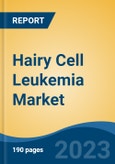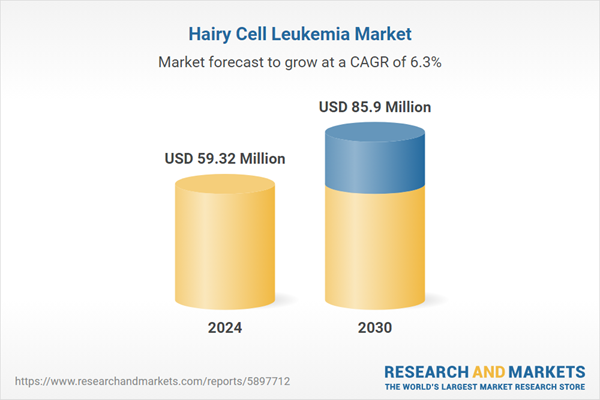Free Webex Call
The Hairy Cell Leukemia Market was valued at USD 59.32 Million in 2024, and is expected to reach USD 85.90 Million by 2030, rising at a CAGR of 6.34%. HCL is a rare, chronic form of leukemia that predominantly affects the blood and bone marrow. The disease is named for the distinctive “hair-like” projections seen on the surface of leukemia cells under a microscope. Speak directly to the analyst to clarify any post sales queries you may have.
10% Free customizationThis report comes with 10% free customization, enabling you to add data that meets your specific business needs.
Characterized by the accumulation of abnormal B lymphocytes in the bone marrow and spleen, HCL progresses slowly and accounts for a small proportion of total leukemia cases. It primarily affects adults, with a higher incidence in middle-aged and older individuals, and is more prevalent among men than women.
In its early stages, HCL may present with minimal or no symptoms. As the disease advances, patients may experience fatigue, weakness, frequent infections, easy bruising, anemia, and splenomegaly. Laboratory findings often reveal neutropenia and thrombocytopenia. Diagnosis typically involves blood tests, bone marrow biopsy, flow cytometry, and, in some cases, genetic testing to identify disease-specific mutations.
Key Market Drivers
Rising Incidence of Hairy Cell Leukemia (HCL)
Although HCL constitutes only about 2% of all leukemia cases, its incidence is gradually increasing. In the United States, approximately 1,200 to 1,300 new cases are diagnosed annually. The prevalence of HCL varies geographically, influenced by genetic and environmental factors. The median age at diagnosis falls between 55 and 63 years, with a higher incidence reported among men.Due to its rarity and often subtle presentation, HCL is sometimes underdiagnosed or misdiagnosed. Improved awareness among healthcare professionals, combined with advancements in diagnostic technologies such as flow cytometry and genetic testing, is enhancing diagnostic accuracy and potentially contributing to the rise in reported cases.
While the exact risk factors for HCL remain unclear, shifts in lifestyle and environmental exposures may play a role. Accurate incidence data are essential for evaluating disease burden and guiding healthcare planning. Additionally, the development of advanced treatment options, including targeted therapies, is improving patient outcomes and may increase diagnosis and treatment rates.
Key Market Challenges
Genetic Heterogeneity
One of the major challenges in the HCL market is genetic heterogeneity, which refers to the presence of diverse genetic mutations among patients. While some cases are linked to identifiable mutations such as BRAF V600E, others may not exhibit the same genetic markers. This variability complicates treatment strategies, as personalized therapies must be tailored to individual genetic profiles.Developing effective targeted treatments requires a comprehensive understanding of the disease’s molecular drivers. This complexity increases both the cost and time required for drug development. Furthermore, designing clinical trials that account for genetic diversity is challenging, as patient responses may vary significantly.
Genetic heterogeneity also contributes to differences in treatment response and the emergence of drug resistance. Accurate diagnosis becomes more difficult in such cases, potentially delaying the initiation of appropriate therapy. Conducting extensive genomic sequencing and molecular profiling to better understand genetic variations demands substantial investment, which can slow the pace of innovation.
Key Market Trends
Empowerment Through Patient Advocacy and Support
Patient advocacy organizations are playing an increasingly critical role in shaping the global HCL market. By promoting awareness, facilitating access to care, and driving innovation, these groups are reshaping the landscape for both patients and healthcare providers.Organizations such as the Hairy Cell Leukemia Foundation and the Leukemia Research Foundation are central to educating the public and medical professionals about this rare disease, which affects roughly 1,200 to 1,300 individuals annually in the U.S., with a median diagnosis age of 55. Their initiatives help reduce diagnostic delays and promote early intervention.
These groups offer vital support services including counseling, helplines, and peer networks. They also empower patients by providing information on treatment options and encouraging participation in clinical trials, which is essential for the development of new therapies. Their advocacy has led to important policy changes that enhance insurance coverage, research funding, and access to medication.
Key Market Players
- Amgen Inc.
- AstraZeneca PLC
- Gilead Sciences
- F. Hoffmann-La Roche Ltd
- Astellas Pharma Inc.
- Johnson & Johnson
- Merck & Co. Inc.
- Pfizer Inc.
Report Scope:
In this report, the Global Hairy Cell Leukemia Market has been segmented into the following categories, in addition to the industry trends which have also been detailed below:Hairy Cell Leukemia Market, By Therapy:
- Chemotherapy
- Targeted Therapy
Hairy Cell Leukemia Market, By End User:
- Hospitals & Clinics
- Ambulatory Care Centers
- Others
Global Hairy Cell Leukemia Market, By region:
- North America
- United States
- Canada
- Mexico
- Asia-Pacific
- China
- India
- South Korea
- Australia
- Japan
- Europe
- Germany
- France
- United Kingdom
- Spain
- Italy
- South America
- Brazil
- Argentina
- Colombia
- Middle East & Africa
- South Africa
- Saudi Arabia
- UAE
Competitive Landscape
Company Profiles: Detailed analysis of the major companies present in the Global Hairy Cell Leukemia Market.Available Customizations:
With the given market data, the publisher offers customizations according to a company's specific needs. The following customization options are available for the report.Company Information
- Detailed analysis and profiling of additional market players (up to five).
This product will be delivered within 1-3 business days.
Table of Contents
1. Product Overview
2. Research Methodology
3. Executive Summary
5. Global Hairy Cell Leukemia Market Outlook
6. Asia Pacific Hairy Cell Leukemia Market Outlook
7. Europe Hairy Cell Leukemia Market Outlook
8. North America Hairy Cell Leukemia Market Outlook
9. South America Hairy Cell Leukemia Market Outlook
10. Middle East and Africa Hairy Cell Leukemia Market Outlook
11. Market Dynamics
12. Market Trends & Developments
14. Porter’s Five Forces Analysis
16. Competitive Landscape
Companies Mentioned
- Amgen Inc.
- AstraZeneca PLC
- Gilead Sciences
- F. Hoffmann-La Roche Ltd
- Astellas Pharma Inc.
- Johnson & Johnson
- Merck & Co. Inc.
- Pfizer Inc.
Table Information
| Report Attribute | Details |
|---|---|
| No. of Pages | 183 |
| Published | April 2025 |
| Forecast Period | 2024 - 2030 |
| Estimated Market Value ( USD | $ 59.32 Million |
| Forecasted Market Value ( USD | $ 85.9 Million |
| Compound Annual Growth Rate | 6.3% |
| Regions Covered | Global |
| No. of Companies Mentioned | 8 |









